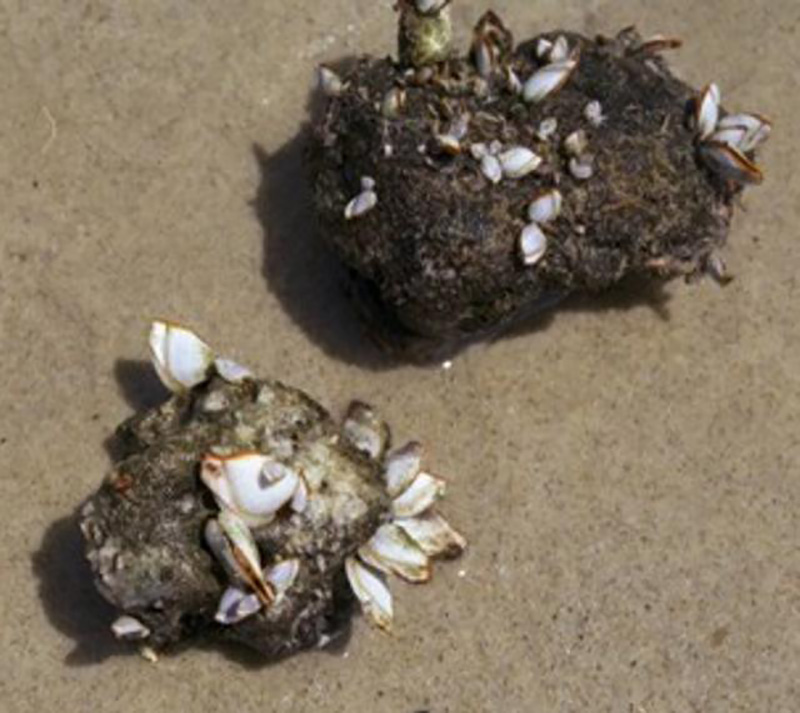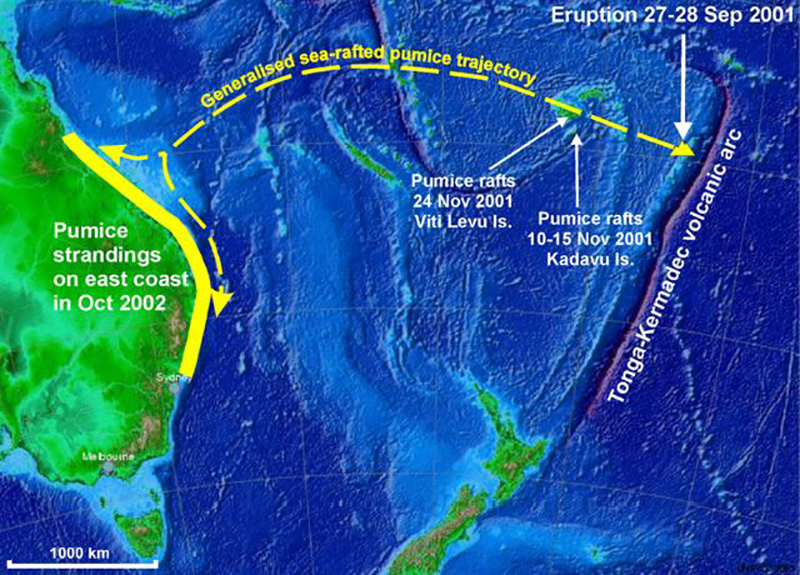Report on Unnamed (Tonga) — October 2003
Bulletin of the Global Volcanism Network, vol. 28, no. 10 (October 2003)
Managing Editor: Edward Venzke.
Unnamed (Tonga) Pumice rafts from September-October 2001 eruption reach eastern Australia
Please cite this report as:
Global Volcanism Program, 2003. Report on Unnamed (Tonga) (Venzke, E., ed.). Bulletin of the Global Volcanism Network, 28:10. Smithsonian Institution. https://doi.org/10.5479/si.GVP.BGVN200310-243091
Unnamed
Tonga
18.325°S, 174.365°W; summit elev. -40 m
All times are local (unless otherwise noted)
A felsic shallow marine explosive eruption from a previously unknown volcano along the Tofua volcanic arc (Tonga) in September-October 2001 (BGVN 26:11 and 27:01) produced floating pumice rafts in Fiji in November 2001, approximately one month after it occurred. These sea-rafted pumice are the only recorded output of this subaqueous eruption at a remote location where direct observations are limited.
A new influx of sea-rafted pumice reached the eastern coast of Australia in October 2002 (figure 4), approximately one year after the eruption was first indicated by seismic activity and pumice stranding in Fiji. Pumice was stranded along at least two-thirds (>2,000 km) of the coastline of eastern Australia, extending from N of Townsville to Sydney. Typical amounts of pumice initially stranded on beaches were 500-4,000 individual clasts per m2; a minimum volume estimate of pumice deposited along the eastern Australian coastline is 1.25 x 105 m3. Most stranded pumice clasts are 1-5 cm diameter, although some outsized clasts are up to 10 cm. Many clasts were fouled by a variety of organisms, and dark algal coverings were common to all clasts that concealed the primary character of the pumice (figure 5). This is in contrast to pumice stranded on beaches in Fiji ~ 1 month after the eruption, which were clean of fouling organisms. Fouling organisms include algae, Bryozoa, serpulid worms, corals and, oysters with goose barnacles particularly abundant.
 |
Figure 5. Closeup of beached pumice clasts from the unnamed volcano in the Tofua volcanic arc fouled by algae and goose barnacles (Lepas pectinata). Courtesy of Scott Bryan. |
The pumice have a low phenocryst content (< 5% modal) with the phenocryst assemblage consisting of calcic plagioclase (An88-74), pigeonite (En45 Fs46 Wo9), augite (En35 Fs29 Wo36), and titanomagnetite. Preliminary petrographic observations in dicate that the pumice is compositionally homogenous, although there is considerable variation in vesicularity within and between clasts. Tubed pumice is a minor but distinctive clast type. The pumice, like previously stranded pumice on the Great Barrier Reef (Bryan, 1968, 1971), is low-K dacite in composition (table 2), characterized by low alkalis and high iron and silica. This composition is similar to other pumice-forming eruptions from the Tonga region (Bryan, 1968).
Table 2. Major element data on sea-rafted pumice clasts from eastern Australia, 2002. Samples HI1 and GC1: major element data for whole pumice clasts determined by the atomic absorption method of silicate rock analysis using Inductively-Coupled Plasma-Atomic Emission Spectroscopy (ICP-AES) at the University of Queensland. Samples P1 and P2 (n=3 for both): averaged pumice glass compositions analysed at the Centre for Microscopy & Microanalysis, University of Queensland, using a JEOL 8800-L (wavelength dispersive) electron microprobe. Analyses were performed with an accelerating voltage of 15 kV and with a probe current of 15 nA and a probe diameter of 10 microns to avoid volatilisation of alkali elements. Courtesy of Scott Bryan and Alex Cook.
| Element | HI1 | GC1 | P1 | P2 |
| SiO2 | 71.30 | 65.90 | 66.84 | 67.33 |
| TiO2 | 0.36 | 0.58 | 0.51 | 0.50 |
| Al2O3 | 12.80 | 12.31 | 12.29 | 12.16 |
| Fe2O3^T | 5.50 | 9.88 | -- | -- |
| FeO^T | -- | -- | 8.05 | 8.04 |
| MnO | 0.10 | 0.18 | 0.16 | 0.15 |
| MgO | 1.07 | 1.43 | 0.93 | 0.92 |
| CaO | 4.34 | 5.77 | 5.40 | 5.23 |
| Na2O | 3.45 | 3.20 | 2.71 | 2.80 |
| K2O | 0.90 | 0.60 | 0.71 | 0.72 |
| P2O5 | 0.18 | 0.15 | 0.18 | 0.20 |
| BaO | -- | -- | 0.03 | 0.05 |
| SrO | -- | -- | 0.17 | 0.16 |
| LOI | 0.92 | 1.87 | -- | -- |
| Raw Total | 99.50 | 99.80 | 97.99 | 98.27 |
References. Bryan, W.B., 1968, Low-potash dacite drift pumice from the Coral Sea: Geological Magazine, v. 105, p. 431-439.
Bryan, W.B., 1971, Coral Sea drift pumice stranded on Eua Island, Tonga, in 1969: Geological Society of America Bulletin, v. 82, p. 2799-2812.
Geological Summary. A submarine volcano along the Tofua volcanic arc ~45 km NW of Vava'u Island was first observed in September 2001, ~35 km S of Fonualei and 60 km NE of Late volcano. The site of the eruption is at an approximate bathymetric depth of 300 m. T-phase waves were recorded on 27-28 September 2001, and on the 27th local fishermen observed an ash-rich eruption column that rose above the ocean surface. No eruptive activity was reported after the 28th, but water discoloration was documented the following month. In early November rafts and strandings of dacitic pumice were reported along the coasts of Kadavu and Viti Levu in Fiji. The depth of the summit of the submarine cone following the eruption was determined to be 40 m during a 2007 survey; the crater of the 2001 eruption was open to the E.
Information Contacts: Scott Bryan, Department of Geology & Geophysics, Yale University, PO Box 208109, New Haven CT 06520 8109 USA; Alex Cook, Queensland Museum, PO Box 3300, South Brisbane, Queensland 4101 Australia.


